|
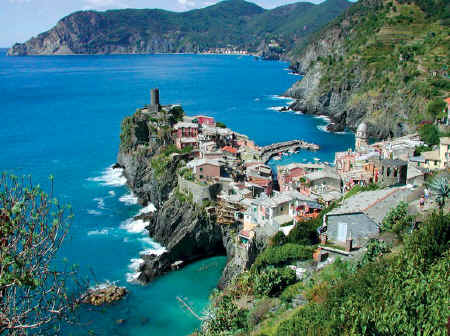
Le Cinque Terre in
Liguria, Italy - Vernazza
The Cinque Terre are five coastal villages in the Province of La Spezia in the
Region of Liguria in Italy. The villages are dotted along eleven miles of sheer rocky coastline
with terraced hillsides and vineyards sloping steeply down to the sea.
Centuries old footpaths and mule tracks wind about 500 to 1,000 feet above the sea, leading through olive groves and vineyards, orchards and chestnut woods.
Although
the Cinque Terre are not in Tuscany they are easily reached from the main Tuscan tourist destinations and in the past few years have become extremely popular among
tourists. Originally, the villages were accessible only by sea or by mule paths that connected the villages
to one another and to Via Roma, the main road that connected all of Italy to Rome. These mule paths have been maintained and used over the centuries and now provide hikers with a
spectacular coastal views. There is now a fee to hike on the
"tourist" trails but the pass also includes the train.
Tickets are available in the Cinque Terre office in each village.
Be sure to take the "milk train" because not all trains
stop at all (or any) the villages.
The five villages are, from northwest to southeast (i.e. from Genoa towards La Spezia):
• Monterosso al Mare
- the beach at Monterosso is the only extensive sand beach in the Cinque Terre.
• Vernazza
is traffic-free and remains one of the most genuine "fishing villages" on the Italian Riviera.
• Corniglia
is on the top of a promontory about 100 m high, surrounded on three sides by vineyards and terraces and the fourth side descends steeply on the sea.
• Manarola
- Manarola's primary sources of income have traditionally been fishing and wine-making. The local wine, Sciacchetrà, is especially renowned.
• Riomaggiore
has a small beach and a wharf framed by tower houses.
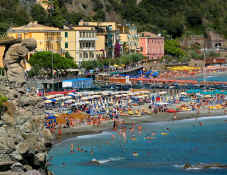
Monterosso al Mare
|
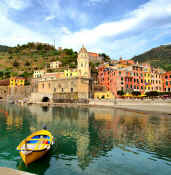
Vernazza
|
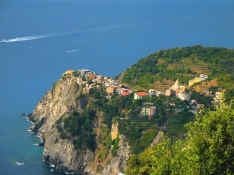
Corniglia
|
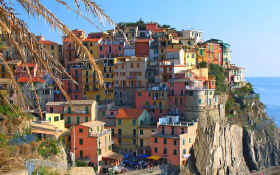
Manarola |
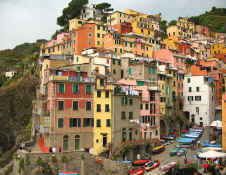
Riomaggiore
|

A
one day excursion from Florence to the Cinque
Terre
Start early! Around 6 am would be a good time.
There is a train from Florence to La Spezia that
bypasses Pisa. This might save you valuable time
since you won't need to change at Pisa. You'll most likely need to change in La Spezia for the last
few minutes on the train route. Journey time 2-3
hours.
There might also be a seasonal a train from Florence direct through to
the Cinque Terre on Sundays.
Descend from the train at Vernazza for breakfast
and then hike north to Monterossa. Next, catch the boat going
south and disembark at Manarola. Hike south on the Via dell'
Amore and end your day in Riomaggiore. Catch the train there to head back to
Florence. |
|
Cinque Terre Villages
Monterosso al Mare is the most visited village among the Cinque Terre, in
large part because it has the only sizable sand beach and the biggest hotels. Though it can get very crowded with tourists during the peak summer months, Monterosso is still delightful. The old town area, separated from the more modern resort area by the Aurora tower, is home to the ruins of a
mediaeval castle and San Francesco church. The latter houses an important Van Dyck
Crucifixion.
Vernazza has the only proper harbour in the Cinque Terre and is a charming, small fishing village.
It was founded about 1000 AD and was ruled by the Republic of Genoa
from 1276. Vernazza's mediaeval castle was built in the mid-1500's, primarily to protect the village from pirates.
Vernazza's historic wealth is reflected in the elegant style of its houses and streets, which are decorated
with open galleries, refined arcades and elaborate doorways. The
village is surrounded by terraced olive groves on the steep slopes.
The olive oil
is reputed to be among the best in the country.
|
The influence of fishing and the
sea is readily evident in the small streets and piazzas of the
Cinque Terre. |
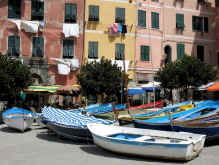
Piazza of Vernazza |
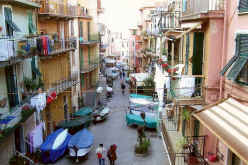
Main street of Manarola |
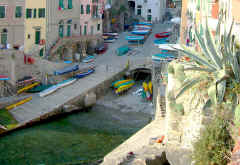
Boats at Riomaggiore |
The village of Corniglia differs significantly from the others of the Cinque Terre
due to its elevated position above the sea. It is located on a
cape a hundred or so metres above the sea and which descends steeply and is inaccessible from the sea. To
reach Corniglia, one has to climb the 'Lardarina', a long series of
brick steps, 33 flights totalling 377 steps. There is also a road that leads from the railway to the village.
Corniglia is mentioned in the Decameron of Giovanni
Boccaccio.
Upon arrival at the railway station, you may need to go underground to reach the main platform. Head down the tunnel toward the city. During World War
II, the residents spent the nights here for protection. Turn right and
head up the hill. This road used to be a stream, with bridges crossing
over it. The stream has since been paved over and you can still hear the running
water beneath. About half way up, there is still an old water wheel. At the top is the church of
San Lorenzo where there is a corner stone dated 1338, suggesting
that Manarola may be the oldest of the towns of the Cinque Terre.
This is the most accessible of the Cinque Terre and although definitely
worth a visit, it does attract the drunken international student
mob during summer with the result that noise during the night can
be a problem if you want to get some sleep.
Cinque Terre Walking Paths
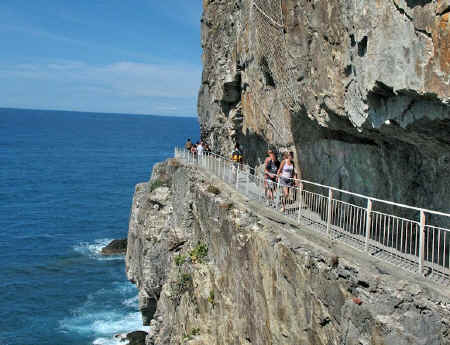
"Via dell' Amore", the path that joins
Riomaggiore to Manarola.
This path is horizontal, short (20 mins) and wheelchair-friendly.
There are well-laid out walking trails connecting each village to its
neighbours. The path from Riomaggiore to Manarola is called the Via Dell'Amore. This winds along the shore, is very picturesque and is
paved, making it a very easy to walk.
The stretch from Manarola to Corniglia is also easy to walk. Although
it is narrow and steep in many places, the trail never becomes excessively
difficult. The main trail into Corniglia finishes with a climb of 368
steps.
The track from Corniglia to Vernazza is not paved and is steep at certain places.
Make sure you go in the direction Corniglia to Vernazza since this
section is almost entirely steps and you will probably prefer to
be going downhill.
The trail from Vernazza to Monterosso is by far the longest and steepest. It winds through olive orchards and vineyards and is rough in places, but offers the best view of the bay and the spectacular approaches to both Monterosso and
Vernazza. There are over 700 steps leading down into Monterosso.
Hiking from Vernazza to Monterosso is easier than going from Monterosso to Vernazza.
All the villages have small hotels or inns, as do some of the smaller villages near the Cinque Terre. There are many
Bed and Breakfast establishments throughout the area that offer excellent service and frequently beautiful views of the Mediterranean and the surrounding hills.
General comments on hiking the Cinque
Terre trails
•
Bear in mind that the efforts of Rick Steves and others have made
these trails extremely popular. On certain days and paths, you can
spend more time dodging fellow hikers than enjoying the view.
•
Wear comfortable and sturdy walking or hiking shoes and not
flipflops nor bare feet.
•
Quite a number of hikers show no consideration for others. If you
face oncoming hikers on narrow sectors, stop and wait against the
cliff face until they pass.
•
Some paths, especially Corniglia to Vernazza, are not for people
who suffer seriously from acrophobia (vertigo).
•
Try not to hike into the hot sun and in any case take a good water
supply with you.
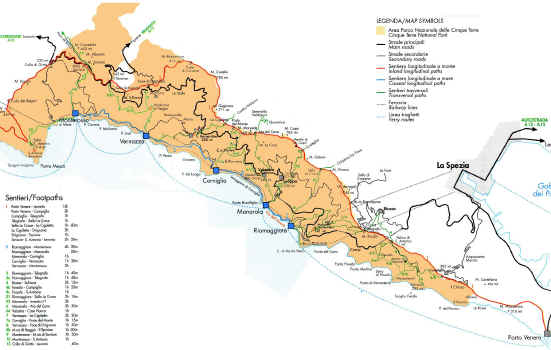
Map of the Cinque Terre Walking Paths
Track No. 1 - SE to NW over the hills (Red Path)
The whole walk, Portovenere to Levanto, about 12 hours.
Portovenere to Campiglia 2 hours.
Campiglia to Telegrafo 1 hour.
Telegrafo to Sella La Croce 1 hour.
Sella La Croce to La Cigoletta 1 hour 40 mins.
La Cigoletta to Drignana 2 hours.
Drignana to Soviore 1 hour.
Soviore to San Antonio-Levanto 2 hours 30 mins.
The track starts at Portovenere with steps flanking the Castle's walls, climbs up rapidly to Sella Derbi,
continues upwards with breathtaking views of the coast until it reaches Campiglia (382
m) and through a beautiful landscape of pine trees joins the Colle del Telegrafo (516
m). Continuing gently uphill amongst Mediterranean vegetation, the track arrives at the Bramapane fork, then leads to Valico La Croce where it starts to climb again among chestnut and pine trees overlooking the coast, and passing the two Selle del Marvede, reaches the Sella della Cigoletta (605
m). From here, the track continues up to Monte Gaginara (800 m), the highest point between Portovenere and Levanto. Now the track
twists down to Termine, where it merges with the main road which, passing the Santuario of Soviore, leads to Colle di Gritta (330
m). Here, after crossing the square with a coffee shop, some steps
lead up to a pine forest and the path continues over the hills dominating the coast (views of Monterosso and Levanto) until it reaches Sella di Punta Mesco from where one enjoys stupendous views.
The path then climbs down to end in Levanto, in the promenade under the Castle.
Track No. 2 Longitudinal at sea-level (Blue Path)
The whole walk, Riomaggiore - Monterosso, about 4 hours 30 mins.
Riomaggiore to Manarola 20 mins.
Manarola to Corniglia 1 hour.
Corniglia to Vernazza 1 hour 30 mins.
Vernazza to Monterosso 2 hours.
From the square of the railway station in Riomaggiore, following the Via dell'Amore
("Path of Love"), in 20 minutes the path takes you to Manarola, where it starts to climb slightly, then flattens up and reaches the
railway station of Corniglia. Here, steep steps lead up to the village (1 hour) where the track starts again and for a long while
stays at the same level above the sea. Next, with some difficult points to negotiate carefully,
it descends to Vernazza (1
hour 30 mins.). From Vernazza the longest and most tricky part of the track (great care and attention are needed) leads up to 180 m. above the sea, then plunges down
towards Monterosso (2 hours).
Transverse Tracks (Green Paths)
3 Riomaggiore to Telegrafo - 1 hour 40 mins.
3a Riomaggiore to Telegrafo - 1 hour 40 mins.
4 Biassa to Schiara 2 hours 15 mins.
4b Fossola to Campiglia 1 hour 20 mins.
4c Fossola to Sant' Antonio 1 hour.
1 Riomaggiore to Sella La Croce 2 hours 15 mins.
2 Manarola to Innesto 2 hours.
6 Manarola to Aia del Cane 2 hours 30 mins.
6d Volastra to Case Pianca 1 hour.
7 Vernazza to La Cigoletta 2 hours 20 mins.
8 Vernazza to Foce di Drignana 1 hour 30 mins.
8b Madonna di Reggio to Il Termine 1 hour 30 mins.
9 Monterosso to Madonna di Soviore 1 hour 30 mins.
10 Monterosso to Sant' Antonio 1 hour.
12 Colla di Gritta to Levanto 40 mins.
How
to get to the Cinque terre
The inaccessibility and lack of parking make access by train to and around the
Cinque Terre the best option. From Genoa, take the train south to Monterosso. Approaching from Pisa – from the south – travel north to La Spezia and on to the Cinque Terre by regional train. Although there are trains that serve all five of the towns, some go direct from La Spezia to
Monterosso. A local train line (the "milk train") from La Spezia to Genoa connects all five villages. The train connecting the five villages runs
for the most part through tunnels for the full distance between Riomaggiore and Monterosso, emerging from the rock infrequently for
brief glimpses of the Mediterranean.
There is a passenger ferry service running between four of the five villages, providing a different vantage point of the rugged coastline and shore line at each village. Ferries do not stop at Corniglia because it does not have a natural
harbour or marina. The boat leaves from Genoa's Old Harbour and La Spezia, Lerici or
Portovenere. There is a road network in the area but this is not a
practical method of access for visitors. And of course there are
the walking paths described above.
Food and wine of the Cinque Terre
Seafood is plentiful in the local cuisine of the Cinque Terre,
not surprisingly, given their locations on the Mediterranean and
the fact that fishing was and is a major activity of the
inhabitants. Anchovies of Monterosso are a local speciality with
DOC status. The mountainsides of the Cinque Terre are heavily terraced and are used to cultivate grapes and olives.
The Cinque Terre and, indeed, the whole region of Liguria, are known for
pesto — a sauce made from ground up basil leaves, garlic, salt, olive oil, pine nuts and pecorino cheese.
Focaccia is a particularly common local baked product. Farinata,
also a typical snack found in bakeries and pizzerias, is essentially a savoury and crunchy
pancake made from a base of chick-pea flour.
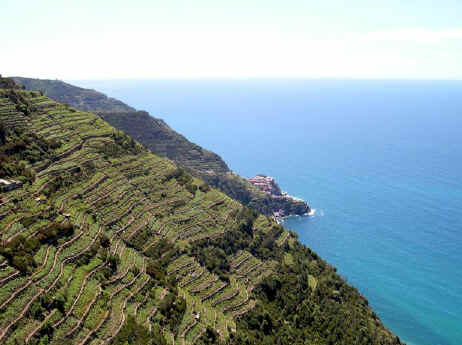
The grapes of the Cinque Terre are used to produce two locally made
white wines. The Cinque Terre (a dry white wine) and the Sciachetrà
(a sweet white wine) are both made using Bosco (an
autochthonous Ligurian grape), Albarola and Vermentino grapes. Both wines are produced by the Cooperative Agricoltura di Cinque Terre, located between Manarola and Volastra. Other DOC producers are Forlini-Capellini, Walter de Batté, Buranco
and Arrigoni
|